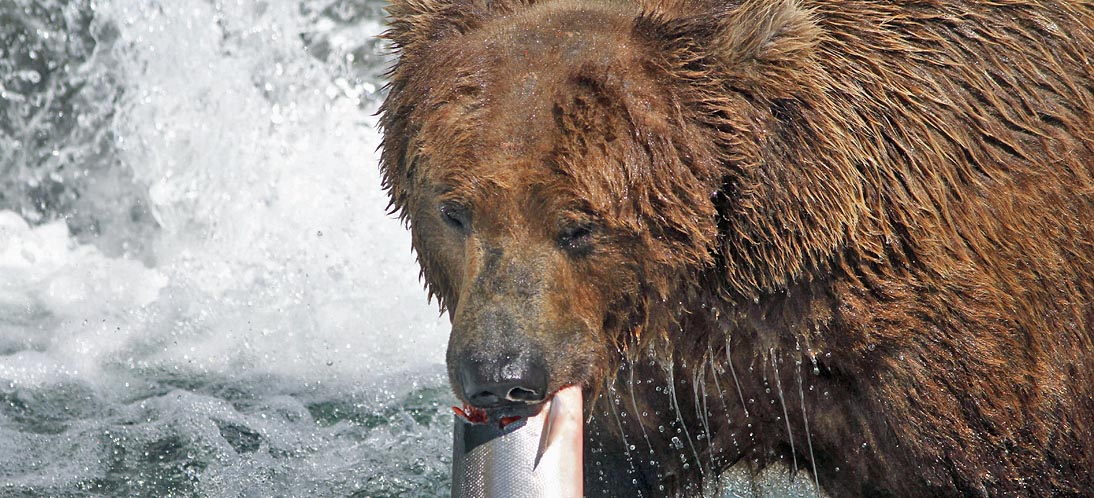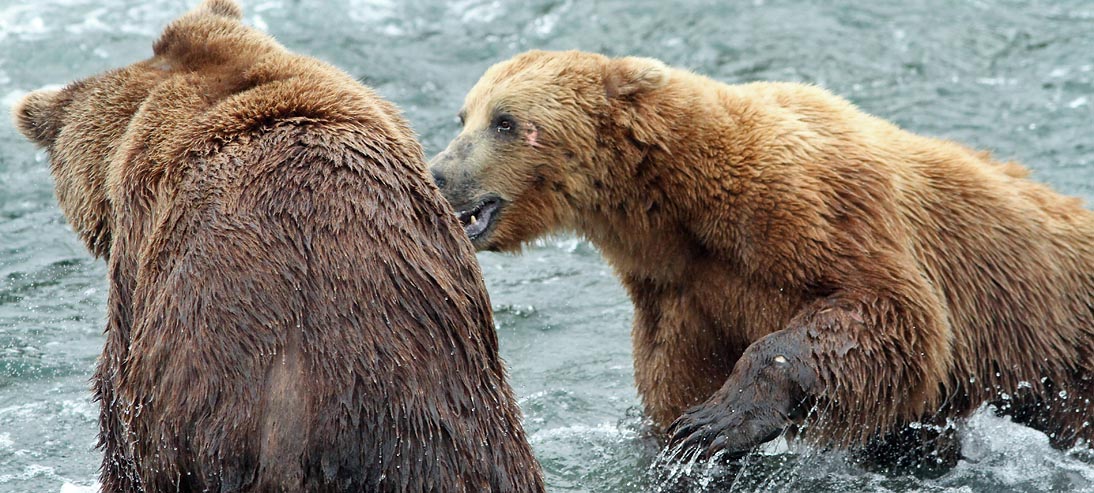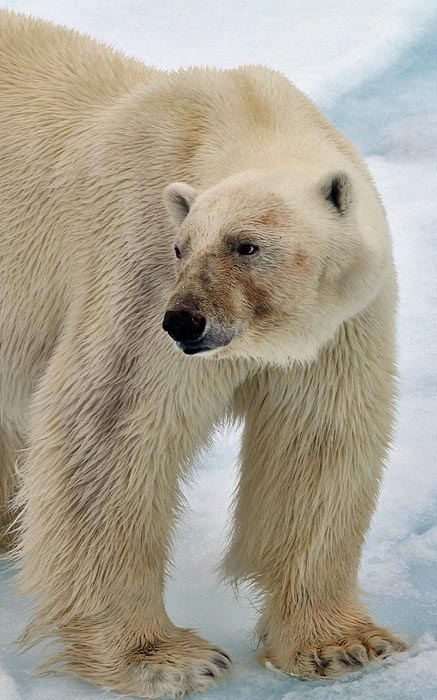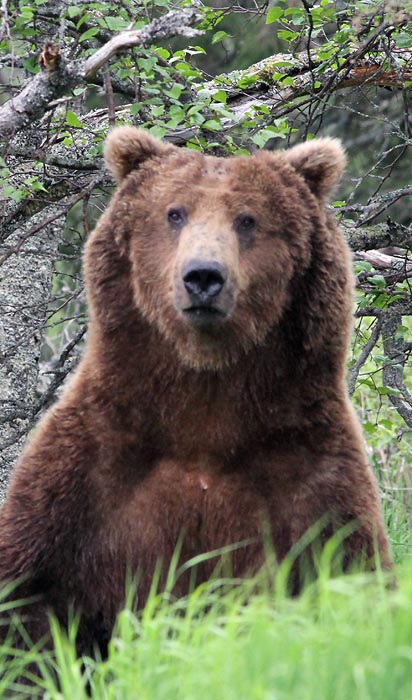| |
|
Polar Bear on ice-sheet north of Spitsbergen 29-30 June 2013 (two different bears shown) © Don Roberson (all photos) |
Polar Bear Ursus maritimus
is the largest land predator on earth. It is a huge carnivorous bear
that averages larger than Brown Bear. Adult males weigh 350-75 kg
(770-1500 lbs) while an adult female is about half that size. The
largest recorded male was shot in northwest Alaska in 1960, weighed
1002 kg (2209 lb) and stood 3.4m (11 ft) tall when mounted on its
hindlegs (Wood 1973).
Despite the claim of
“largest land predator,” Polar Bears can be called "marine mammals."
Much of their life is spent on the sea-ice and they swim readily and
easily. They routinely cross large bodies of ocean and have been seen
in the Arctic Ocean 300km (200 mi) from land. They concentrate at the
edge of the polar ice-pack, where their prey [primarily Ringed Seals Pusa hispida and Bearded Seals Erignathus barbatus] is most abundant.
For
the most part, humans are few within the Arctic range of Polar Bear,
and deadly confrontations are few. Humans kill far more bears than
bears kill people. Yet, Polar Bear is a very dangerous animal. Bears
are fearless towards people; they are very curious and are
unpredictable in temperament; and in the right circumstances one will
stalk, kill, and eat a human as prey. Many attacks by Brown Bears are
the result of surprising the bear, but this is not the case with Polar
Bears. These alpha predators are stealth hunters and a victim is often
unaware of the bear’s presence until the attack is underway. Whereas
Brown Bears often maul a person and then leave, a Polar Bear attack is
more likely to be predatory and is almost always fatal; Stirling
(1988). Yet, man is not a preferred prey and attacks may be by hungry
bears in unusual circumstances.
While Polar
Bears have attacked large mammals like Svalbard Reindeer or even
Musk-ox, their biology requires a large amount of fat from marine
mammals; there are insufficient calories in terrestrial food; Ramsey
& Hobson (1991), Ovsyanikov 1996. Humans are at a huge disadvantage
in the barren and frozen habitat of Polar Bears. A bear can smell a
seal a mile away and in a den buried under 3 feet of snow. It can smell
a human a long way off. It has good hearing and excellent vision. It
knows how to blend into the habitat through cunning and stealth. A bear
can outrun you. Man’s only significant defense is a gun. In places like
Svalbard, north of Norway, people are warned at the edge of each town
that this is Polar Bear country – enter at your own risk. Even wildlife
tours to Arctic Svalbard routinely have leaders carrying guns at all
times – and posted as look-outs – any time tourists are permitted off
ships and come ashore.
|
|
|
| Despite
all this, people can have fabulous interactions with Polar Bears from
safety. In Churchill, Manitoba, Canada, drivable Tundra Buggies take
tourists in comfort to bear congregation sites in late autumn. There
are camping expeditions to the Arctic in summer that observe bears from
a distance; the boneyard at Pt. Barrow, Alaska, is also well-known as a
spot to sometimes see individual bears with the protection of a guide
with a gun. More recently, Arctic cruises in North America, Greenland,
or Svalbard offer excellent encounters with bears from ships able to
enter the ice-pack in summer, or from zodiacs cruising bays and shores
on the mainland.
The photos here were taken on a
Svalbard cruise. Curious bears may come right up to the ship when
within the ice-pack; during our cruise an outdoor barbeque on the
fantail of the ship attracted a big male (middle photo). If one is very
lucky (as we were) one might observe predation of seals and
interactions between bears. Polar Bears hunt seals in three distinct
ways: (a) they smell a baby seal in a birth-chamber under the snow and
dig it out; (b) they wait at an air-hole until a seal surfaces for air
and grab it with a powerful swipe of its paw [in fact, a Polar Bear has
been documented pulling a Beluga from an ice-hole when the whale
surfaced for air]; or (c) they stalk a seal resting on the ice. Bears
often approach lounging seals by swimming or by stealth. We saw several
instances of bears feeding on a seal carcass on the ice-sheet north of
Svalbard, but in each case the seal was already dead when we arrived.
Most dramatically, we watched a large male chase an adult female off
her kill. She had killed a large Bearded Seal (photos top & bottom)
that was larger and heavier than she was. The male bear chased her off
and then chose to pick up the carcass — which appeared to weigh more
than he did — and carry it some distance on the ice to be devoured at a
spot that he preferred. Truly an impressive show of immense strength! |
|
Polar Bear on ice-sheet north of Spitsbergen 29-30 June 2013 (with Glaucous Gulls and Ivory Gull) © Don Roberson (above) |
| |
Brown Bear at Brooks Falls, Katmai NP, Alaska 30 June-1 July 2011 © Don Roberson (below) |
|
Brown Bear at Brooks Falls, Katmai NP, Alaska 30 June-1 July 2011 (four different bears shown) © Don Roberson (all photos) |
Brown Bear Ursus arctos
is the alpha predator across the forested Holarctic. There are several
subspecies but their limits are subject to debate. Genetically, it
appears that in the Old World there are two clades within the nominate
subspecies, and others in Central Asia. In North America, there are 3
or 4 clades (including a California clade that is extinct); Garshelis
2009). Within the subspecies currently called Ursus arctos horribilis,
two groups are generally recognized—the coastal Brown Bear and the
inland Grizzly Bear -- these two types broadly define the range of
sizes of all brown bear groupings. An adult Grizzly living inland in
Yukon may weigh as little as 80 kg (180 lb) while an adult coastal
Brown Bear living on a steady diet of spawning salmon may weigh as much
as 680 kg (1500 lb). Obviously it is these huge bears that appear to be
the most scary. Yet, the abundance of salmon, especially during the
summer spawn, focuses the attention of these bears and their
interactions with people at such places are mostly without incident.
One of those locales is Brooks Falls, Katmai NP, Alaska, where these
photos were taken.
It seems in the incidence of
bear attacks is primarily inland, perhaps due to limited food and
hungry bears, or perhaps because it is easier to come unexpectedly upon
a bear inland. Brown Bears do not take well to surprise. Fatal attacks
by Brown Bears in North America average about two per year (Herrero
2002). The Alaska Science Center (Smith & Herrero 2008) ranks the
following as the most likely reasons for bear attacks: surprise,
curiosity, protection of young, predatory intent, wounded hunted bear,
carcass defense, and provoked charge. Unlike smaller Black Bears Ursus americanus
that can climb trees, adult Brown Bears respond to danger by standing
their ground and warding off their attackers. Mothers defending cubs
are the most prone to attack, being responsible for 70% of Brown
Bear-caused human fatalities in North America (Herrero 2002).
A
wounded bear is a dangerous bear. In 1915, a gigantic male known as
"Kesagake" visited the village of Sankebetsu, Hokkaido, Japan, to feed
on harvested corn. The bear was shot by two villagers and fled to the
mountains, injured. On 9 Dec 1915, Kesagake showed up again, killing 6
people in two days, eating some and stashing others away. A famed bear
hunter finally shot "Kesagake" on 14 Dec. The bear was almost 3m
(nearly 10 ft.) tall and weighed 380 kg (837 lb). Human remains were
found in his stomach. The region was abandoned by villagers for fear of
more bear attacks, and it became a ghost town. Even today, the
Sankebetsu incident remains the worst animal attack in the history of
Japan. Kimura Moritake (1994) published a book on the incident, and
there are Japanese movies and plays based upon the story.
Given
all these concerns, one does not wish to come upon a Brown Bear
unexpectedly, or get between a mother and cub. However, like many land
predators, humans are more a threat to bears than they are to us.
Quammen's Monster of God chapter on bears focused on Brown
Bears in Romania; the purpose of bear reserves there [i.e., as hunting
locales for the rich and famous, and most infamously, dictator Nocolae
Ceausescu; the wardens relationship with the bears and the dictator;
and what happened to all of them.... great reading]. |
|
|
In
Alaska, viewing or photographing Brown Bears at places like Brooks
Falls can be rewarding. The excitement is best during the big salmon
run (usually late June-early August, but it can vary earlier or later
year to year) and reservations must usually be made a year or more in
advance. Lodging (mostly comfortable cabins) is limited and fills up
fast. Meals were great — fresh salmon every day, just like the bears!
The two levels of viewing decks adjacent to and slightly above Brooks
Falls are often crowded with photographers and tourists, and at busy
times one has a limited time at the viewing deck. It is good to come
early or late in the day. Upon arriving at Brooks Lake by float plane
(the only way to get there), one must listen to a mandatory lecture on
living among bears. One is no permitted to carry any food of any type;
fisherman must cut fish off their lines if a bear approaches; and the
pontoon bridge across the river — the only access to the Brooks Falls'
viewing platform — is closed whenever a bear gets too close. When one
watches the situation at the falls for a time, it becomes apparent that
there is a real hierarchy among the bears there. The largest males have
the prime locations and younger bears slink away when one of the big
beasts arrive. At other times there are noisy encounters or actual
fights — the bears shown below are disputing a spot near the falls, and
one bear shows injuries from a previous such engagement.
If
you stay a few days, you may encounter a wild Brown Bear on your own.
The viewing platform and the walkways leading to it are carefully
fenced and above-ground, but many trails in the park are through bear
country. I was alone one morning, slowly birding along one of those
paths, when I heard something running down the trail towards me. Having
taken the mandatory course on arrival, I recognized it was likely a
bear, and stepped back off the trail, next to a tree. Suddenly a
smallish, young-looking bear rushed past me down the trail. But I again
remembered the lecture.... where one bear is running, there is likely
another bear to follow. So I stayed still. And yes, a decidedly larger
bear came trotting past — a mid-sized male — and he stopped to turn and
look at me. Deciding that I was less interesting than the female bear
in heat which he was chasing, he quickly rumbled on again. Later I
heard he had dashed through the main camp and past the dining room in
efforts to locate that young sow. Still — a nice heart-skipping bit of
adventure.
|
|
| |
Click below for the next page of this project
OR use these LINKS to the SPECIES PAGES
|
|
Photos: All photos © Don Roberson, except as otherwise attributed; all rights reserved.
Literature cited:
Garshelis, D.L. 2009. "Ursidae (Bears), " pp. 448 –497 in Handbook of the Mammals of the World, Vol. 1 (D.E. Wilson & R.A. Mittermeier, eds). Lynx Edicions, Barcelona.
Herrero, S. 2002. Bear Attacks: Their Causes and Avoidance, revised ed. Lyons Press, Guilford, CT.
Moritake, K. 1994. The Devil's Valley, Kyodo bunkaska, Tokyo.
Ovsyanikov,
N.G. 1996. Interactions of polar bears with other large mammals,
including man. Journal of Wildlife Research, 1: 254–259.
Quammen, D. 2003. Monster of God: the Man-Eating Predator in the Jungles of History and the Mind. Scribner, New York.
Ramsay,
M. A., and K.A. Hobson, K. A. 1991. Polar bears make little use of
terrestrial food webs: evidence from stable-carbon isotope analysis.
Oecologia 86: 598–600.
Smith, T. S. and S. Herrero, S. 2008. "Ursus arctos californicus." Alaska Science Center – Biological Science Office.
Stirling,
I. 1988. Polar Bears. Ann Arbor: University of Michigan Press. Wood,
G.L. 1973. The Guinness Book of Animal Records. Doubleday, New York.
|
|
|






